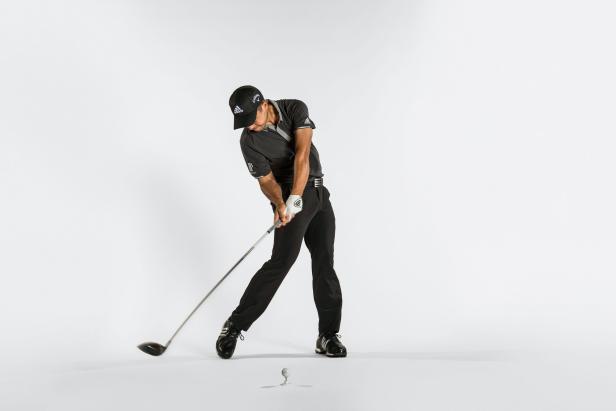Hard Ball: How a small guy like Xander Schauffele kills it off the tee

EDITOR’S NOTE—Entering 2024, Xander Schauffele topped many lists as the best player without a major victory. That changed in a big way this season, when Schauffele fended off Bryson DeChambeau at the PGA Championship, before storming ahead on the final nine to claim the Open at Royal Troon. His two-major-win season is the first since Brooks Koepka in 2018. Schauffele’s prowess off the tee in collecting both titles got us remembering this instruction story that Schauffele wrote for Golf Digest in March 2018. The secrets to his success off the tee that he shares below continue to be helpful tips for all golfers.
Ever since my early teens, I’ve tried to swing the driver very fast. Back then, it was as fast as I could. But now that I’m 24, I’m working to dial back some of that speed, knowing I have an extra gear if needed. The goal is to protect myself from injuries down the road—especially to my back. That being said, I’ll always swing my swing. My hips will always lead in the downswing, and I’ll always fire off my right foot. I know Tiger and other big hitters keep their right foot down and mainly use their bodies to power through the ball, but I’m not Tiger’s size.
Some TV analysts have said that Justin Thomas and I generate big drives the same way. I’m 5-10, 175 pounds. Justin is similar. We’re small compared to many other long hitters, so we have to push off our right side—use the ground as much as we can—to hit big drives. He kills it. And I’d like to think I’m pretty long, too. When I outdrive someone much bigger than me, it proves that my motion is more efficient, more “in-tune.”
The point I’m trying to make is that no matter what your physical limitation might be, you can always find some extra yardage if you know where to look. Let me point you in the right direction with a few things from my game plan. These are feels and drills that my father and coach, Stefan, taught me as a junior, and I still use them. I think they’re universally applicable to hitting it farther. Give them a try, and see if they don’t boost your distance numbers. —X.S. with Ron Kaspriske
Before I help your setup, here’s a good analogy for understanding how to put more power into your drives. When I was a kid, my dad would give me a hammer and tell me to drive a nail into a wooden block with a single strike. To do that, I had to swing the hammer fast but also deliver that power into the back of the nail at just the right moment, or I’d do some damage—to my hand or the block. I learned to hold back the speed until the last moment. Think about doing the same when you swing your driver into the ball.
One thing that will help you unleash that power at the right moment is your grip. Mine is neutral. For a stock shot, I see only one knuckle on my glove hand when I look down. This grip allows me to hit draws or fades when I want to. It also lets me release the clubhead into the ball like I’m hammering that nail. If your grip is too strong, you can’t fully release the clubhead, typically resulting in a loss of speed. And a grip that’s too weak makes it tough to square the clubface at impact, so you lose control.
Another thing to pay attention to at address is shaft lean—especially if you’re setting up for power. When you hold the club with your glove hand, check that the shaft points at least at your left shoulder bone near the armpit (above). With a ball position just inside your left heel like I have it here, the shaft will be perpendicular to the ground. To really launch a drive, I play the ball slightly farther forward than that, so I can strike it more on the upswing. Hitting the ball on the way up decreases backspin and helps increase carry distance. But playing the ball too far forward is not advisable, as it will inevitably lead to compensation moves and an overall loss of balance.
Remember a few years ago when Tiger said his glutes shut off? I know he wasn’t kidding because when I reach the top of my swing, like Tiger, I want to feel my right glute muscles firing. You don’t drift off the ball or simply turn away from the target if you want to crunch one—you load (above). And you’ll know you’re doing it right if the glutes on the trail side of your body are flexed.
Try this drill: Get into your setup, and swing the club forward like you’re rehearsing a follow-through, then immediately make a backswing from this spot. Even if you do this without a club, you’ll sense you’re loading more into the trail side. Why does this matter? If you load up on the backswing, your forward swing will be that much more potent.
My father was a track-and-field athlete, and he taught me that the biomechanics in throwing can be directly applied to hitting sports like golf—specifically weight transfer and the sequence of motion of the body, arms and club. My step-out drill works off that principle.
I start with my feet close together, my left foot pulled back, and the clubhead about a foot behind the ball (above). I then start my swing, but as my upper body and club are still turning away from the target, I step toward it with my left foot, plant it firmly, and swing through. At times, I actually play entire practice rounds doing this. It helps reinforce the feeling of a good weight shift forward in the downswing, leading with the lower body. It also trains the synchronization of movement from the ground up (legs, hips, torso, arms and, finally, the club). This is the drill I think will benefit you the most. Get your weight onto your front side, and you can put a lot of energy into the ball. In fact, you’ll hammer it.
Related
5 Things I Never Play Golf Without: David Dusek
Our 11-handicap equipment writer always brings his favorite divot repair tool, a portable speaker and some high-tech gear to the course.As long as the weather i
Donald Trump’s golf course wrecked by pro-Palestine protesters
Pro-Palestinian protesters have vandalized parts of U.S. President Donald Trump's golf course in Scotland in response to his proposal for the reconstruction of
Man holding Palestinian flag scales London’s Big Ben hours after…
CNN — Emergency services were called to London’s Palace of Westminster on Saturday a
EPD: Drunk driver parked car on golf course
EVANSVILLE, Ind. (WFIE) - Evansville police say they arrested a man after finding him drunk in his car that was parked on a golf course.Officers say they were c











